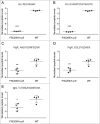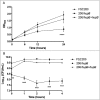HU protein is involved in intracellular growth and full virulence of Francisella tularensis
- PMID: 29473442
- PMCID: PMC5955460
- DOI: 10.1080/21505594.2018.1441588
HU protein is involved in intracellular growth and full virulence of Francisella tularensis
Abstract
The nucleoid-associated HU proteins are small abundant DNA-binding proteins in bacterial cell which play an important role in the initiation of DNA replication, cell division, SOS response, control of gene expression and recombination. HU proteins bind to double stranded DNA non-specifically, but they exhibit high affinity to abnormal DNA structures as four-way junctions, gaps or nicks, which are generated during DNA damage. In many pathogens HU proteins regulate expression of genes involved in metabolism and virulence. Here, we show that the Francisella tularensis subsp. holarctica gene locus FTS_0886 codes for functional HU protein which is essential for full Francisella virulence and its resistance to oxidative stress. Further, our results demonstrate that the recombinant FtHU protein binds to double stranded DNA and protects it against free hydroxyl radicals generated via Fenton's reaction. Eventually, using an iTRAQ approach we identified proteins levels of which are affected by the deletion of hupB, among them for example Francisella pathogenicity island (FPI) proteins. The pleiotropic role of HU protein classifies it as a potential target for the development of therapeutics against tularemia.
Keywords: DNA binding protein; FPI; Francisella; HU protein; nucleoid-associated protein; virulence.
Figures










Similar articles
-
Characterization of tetratricopeptide repeat-like proteins in Francisella tularensis and identification of a novel locus required for virulence.Infect Immun. 2014 Dec;82(12):5035-48. doi: 10.1128/IAI.01620-14. Epub 2014 Sep 22. Infect Immun. 2014. PMID: 25245806 Free PMC article.
-
Arginine 58 is indispensable for proper function of the Francisella tularensis subsp. holarctica FSC200 HU protein, and its substitution alters virulence and mediates immunity against wild-type strain.Virulence. 2022 Dec;13(1):1790-1809. doi: 10.1080/21505594.2022.2132729. Virulence. 2022. PMID: 36226562 Free PMC article.
-
Hfq, a novel pleiotropic regulator of virulence-associated genes in Francisella tularensis.Infect Immun. 2009 May;77(5):1866-80. doi: 10.1128/IAI.01496-08. Epub 2009 Feb 17. Infect Immun. 2009. PMID: 19223477 Free PMC article.
-
Molecular and genetic basis of pathogenesis in Francisella tularensis.Ann N Y Acad Sci. 2007 Jun;1105:138-59. doi: 10.1196/annals.1409.010. Epub 2007 Mar 29. Ann N Y Acad Sci. 2007. PMID: 17395737 Review.
-
Proteins involved in Francisella tularensis survival and replication inside macrophages.Future Microbiol. 2012 Nov;7(11):1255-68. doi: 10.2217/fmb.12.103. Future Microbiol. 2012. PMID: 23075445 Review.
Cited by
-
Nε-lysine acetylation of the histone-like protein HBsu influences antibiotic survival and persistence in Bacillus subtilis.Front Microbiol. 2024 May 21;15:1356733. doi: 10.3389/fmicb.2024.1356733. eCollection 2024. Front Microbiol. 2024. PMID: 38835483 Free PMC article.
-
Bacterial nucleoid-associated protein HU as an extracellular player in host-pathogen interaction.Front Cell Infect Microbiol. 2022 Aug 23;12:999737. doi: 10.3389/fcimb.2022.999737. eCollection 2022. Front Cell Infect Microbiol. 2022. PMID: 36081771 Free PMC article. Review.
-
Phosphorylation Regulation of a Histone-like HU Protein from Deinococcus radiodurans.Protein Pept Lett. 2022;29(10):891-899. doi: 10.2174/0929866529666220819121911. Protein Pept Lett. 2022. PMID: 35986527 Free PMC article.
-
Deciphering the Proteomic Landscape of Mycobacterium tuberculosis in Response to Acid and Oxidative Stresses.ACS Omega. 2022 Jul 18;7(30):26749-26766. doi: 10.1021/acsomega.2c03092. eCollection 2022 Aug 2. ACS Omega. 2022. PMID: 35936415 Free PMC article.
-
Pathogenicity and virulence of Francisella tularensis.Virulence. 2023 Dec;14(1):2274638. doi: 10.1080/21505594.2023.2274638. Epub 2023 Nov 8. Virulence. 2023. PMID: 37941380 Free PMC article. Review.
References
-
- McDonald MK, Cowley SC, Nano FE. Temperature-sensitive lesions in the Francisella novicida valA gene cloned into an Escherichia coli msbA lpxK mutant affecting deoxycholate resistance and lipopolysaccharide assembly at the restrictive temperature. J Bacteriol. 1997;179:7638–7643. doi: 10.1128/jb.179.24.7638-7643.1997 - DOI - PMC - PubMed
Publication types
MeSH terms
Substances
LinkOut - more resources
Full Text Sources
Other Literature Sources
